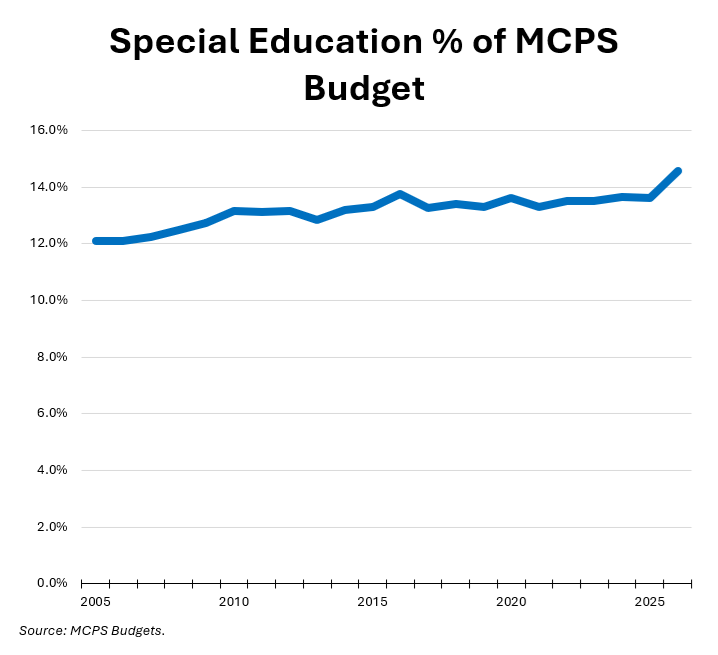By Adam Pagnucco.
Part One outlined the largest increases in Superintendent Thomas Taylor’s recommended FY26 operating budget. Part Two examined fixed charges (employee benefits). Today, let’s look at the category accounting for his second-largest dollar increase: special education.
The Financial Reporting Manual for Maryland Public Schools defines category 6 (special education) this way: “Activities designed for students who, through appropriate assessment, have been determined to have temporary or long-term special education needs arising from cognitive, emotional, and/or physical factors, as defined in the State Board of Education’s Special Education Bylaw.”
Special education has long been a controversial topic in MCPS. It’s the third largest category of MCPS spending (behind instructional salaries and fixed charges/benefits) and accounts for a substantial portion of MCPS’s legal fee budget. According to MCM, here is what Taylor said about special education to the Montgomery County Taxpayers League last November:
*****
“Special education needs a complete overhaul on how we deliver services,” he said. “There is surplus money in the budget to hire more staff.”
However, he told taxpayer league members on the call that fixing special education “is going to be a very long and arduous journey.” He added, “This is a massive undertaking.”
He pointed to problems with understaffing, the way students are grouped, and communications with parents as some of the major issues in the special education program.
Parents are “exhausted,” he said, adding, “You need to know I hear and see” those involved with special education.
*****
Taylor’s budget makes it loud and clear that he hears everyone involved with special education. This excerpt discusses the topic.
*****
Prominent in every community discussion I have had since becoming superintendent of schools has been the needs of our special education students and the frustrations of families and school staff with service delivery. As a district, we must do better to serve our students with disabilities, and at a minimum we must meet the staffing standards that we have set forth as our current goal. My Recommended FY 2026 Operating Budget includes an additional 688.6 FTE and $46. 7 million to align the budget to our current staffing guidelines. This total includes 188 teachers, and 500 new paraeducator positions. Of the paraeducator positions, a number are temporary part-time positions converted to full time. The conversion to full-time positions makes these positions less expensive.
*****
As shown in Part One, Taylor’s expansion of positions in special education accounts for a whopping 81% of the new positions in his budget. His 37-page special education staffing plan contains considerable detail on what he would like to do. In terms of dollars, his increase for special education ($75.7 million) ranks second behind fixed charges/benefits and accounts for more than a quarter of the total increase he is recommending.
Taylor’s allocation for special education is so large that its share of MCPS’s operating budget would be at its highest level in more than 20 years. The chart below shows the percentage of the budget going to special education since FY05. Taylor’s percentage of 14.6% is bigger than any posted by his last five predecessors.

One aspect of this gives me pause. Taylor wants to add 718 FTEs in the special education category in one year. That’s equivalent to MCPS’s total expansion of positions in this category since FY19. Essentially, Taylor believes he can hire as many people for special education in one year as MCPS had in the prior six years combined.
Special education jobs are TOUGH. It’s hard to find people who can do them, much less at a high level. Can Taylor find that many special education employees in one year? And if he can’t, what happens to the tens of millions of dollars he would like to use to fund them?
Next: textbooks and instructional supplies.
